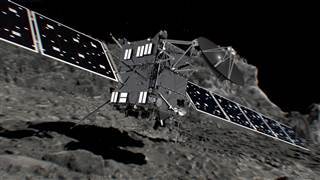Rosetta, the comet-chasing spacecraft that traveled four billion miles over the course of a decade, is now ready for its grand finale.
After catching up to Comet 67P and spending two years observing the rubber-duck shaped comet and conducting scientific measurements, the European Space Agency’s probe is ready to say goodbye.


Around 7:20 am ET, the spacecraft will gather one final set of science observations during its descent before a mission-ending collision with an icy comet.
Related: Historic Comet Lander to Be Switched Off Forever
Rosetta, and its companion Philae lander, have given scientists a trove of information to help shed new light on the beginnings of the solar system. Here’s a look at a few memorable moments from the mission.
Catching up to a Speeding Comet
Rosetta made history when it reached Comet 67P on August 6, 2015, marking the culmination of a 10-year, four-billion-mile journey. Its Philae landed on Comet 67P on November 12, 2014.
While the event was historic, Philae had a bouncy landing, coming to rest in a position that obscured some of its solar panels. The landing spot led to Philae having intermittent contact with Rosetta, which was its line of communication back to Earth.
This Comet Sings
Scientists were expecting to see a lot on Comet 67P, but they never expected it would greet them with a song. It’s believed the song comes from oscillations in the comet’s magnetic field, according to the ESA.
Going Beneath the Surface of 67P
You’d expect the interior of a comet to be stone cold, but Rosetta has a soft side.
Using radio waves, Rosetta and Philae were able to give scientists a picture of what the interior of the comet looks like.
Comets are mixtures of dust and ice. However, scientists were surprised to learn 67P is porous and comprised of fluffy dust particles mixed with ice, proving the old comet is a big softie inside after all.
Mystery Deepens: How Did Earth Get Its Water?
One of the most surprising findings challenged the theory that water was brought to Earth by comets. Rosetta’s instruments analyzed the signature of water vapor on 67P and determined the comet’s water wasn’t a match for the structure of Earth’s H2O.







